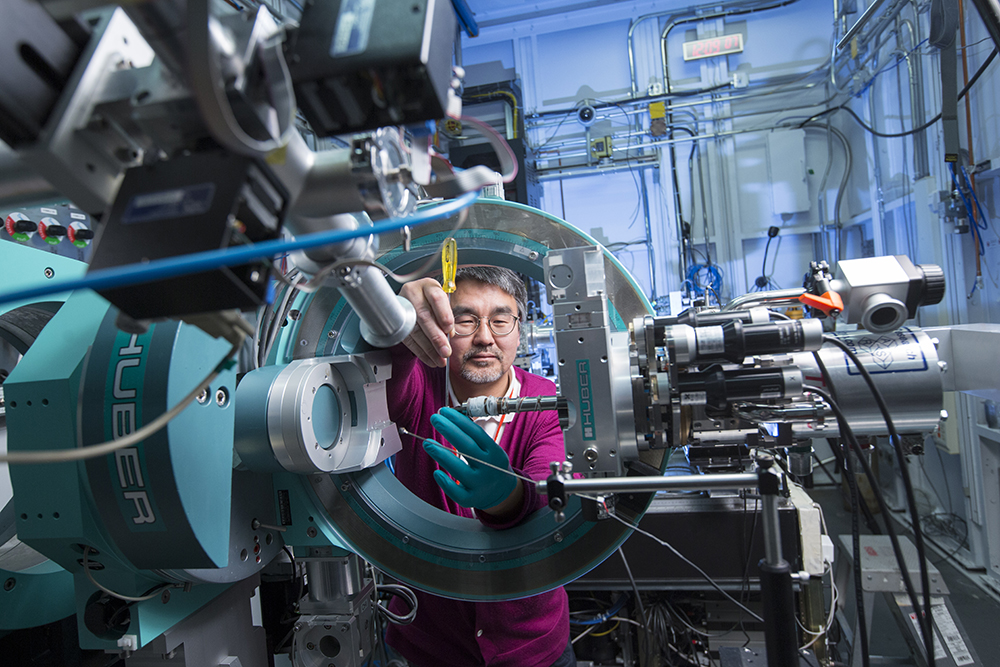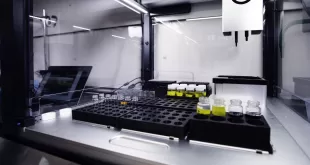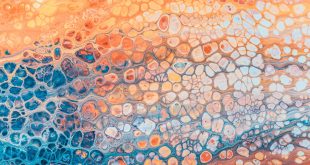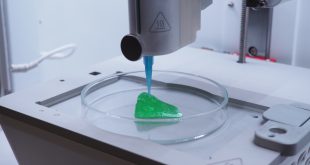By Jana Manolakos

David Stobbe / stobbephoto.ca
Observing molecular behavior with one of the world’s most advanced generators of synchrotron light, The Canadian Light Source (CLS), is a multi-million dollar national research facility.
In Saskatoon, they say that when your dog runs away, you can watch him run for days. In the vast golden plain of the Canadian prairies, the distance would reduce him to nothing more than a spot on the horizon. But what if there was a light beam trained on your dog that was so powerful it could interact with the molecules in every follicle of his tail from miles away?
With one of the world’s most advanced generators of synchrotron light, the Canadian Light Source (CLS) is a multi-million dollar national research facility at the University of Saskatchewan in Saskatoon that delivers forms of light so powerful they let researchers observe the interplay of molecules in material that is exponentially smaller than your dog in the distance.
“The light we generate ranges anywhere from infrared and visible ultraviolet to X-rays,” says Jeff Cutler, its Chief Strategic Relations Officer. With a PhD in physical chemistry from Western University, he is no stranger to the facility, having been involved with it when planning first began in the mid-90s. He left shortly thereafter, returning in 2000. “They broke ground in late 1999 and user operations started in 2005.”
The number and variety of experiments here are astonishing, capturing new knowledge in nanotechnology, micro-manufacturing, environmental science, agriculture and the health and life sciences, and in the process giving rise to an impressive list of discoveries – new drugs, effective motor oils, better computer chips, a cleaner environment and more.
“On any given day, you can have a team looking at pharmaceutical research in one part of the building and another group just down the hall working on aircraft material while still others are doing mining research. It really is an enabler of almost every sector of importance to Canada. I always say that working here is the coolest science job in the country because it touches on so many different areas,” Cutler says.
At roughly the size of a football field, the building houses a 103-metre booster ring and 171-metre storage ring within a cavernous hall of instruments, work stations, and miles of electrical wires and cables. Two storeys below ground sits a massive electron gun. It’s one of the reasons the facility is licensed by the Canadian Nuclear Safety Commission.
In 1964, there was an old nuclear physics lab here – the Saskatchewan Accelerator Laboratory, known around the campus as SAL, Cutler recalls. “It was a facility dedicated to nuclear physics where they slammed charged particles into various materials to look at nuclear processes using an electron gun. We are still using that same electron gun as a source of electrons for the synchrotron itself. That was part of the reason that Saskatoon was picked as the site because of the expertise and the fact that this electron gun already existed.”
This equipment forms part of a complex technological space in which charged particles or electrons, are taken almost to the speed of light and bent through magnets causing them to radiate a range of wave lengths of light through ‘beamlines’.
“Think about the old incandescent light bulbs,” Cutler says. “You have that glowing hot filament at the centre of the tube boiling off all sorts of electrons – it’s the same sort of idea here. We heat up a piece of tungsten; make it very hot, about 1,000C. It glows. We suck those electrons off, and accelerate them towards the speed of light. When it comes out of our electron gun, it’s going about 99.9995 per cent of the speed of light.”
But that’s not fast enough he says. So it goes from the linear accelerator to a booster ring inside the bigger storage ring. That booster ring then takes those electrons and “gives them a further kick in the pants” as Cutler puts it, where a radio frequency cavity increases their velocity to about 99.999998 per cent of the speed of light, travelling around the ring 1.5 million times in 0.6 seconds – fast enough to reach the moon in one second. And that’s the energy researchers are looking for.
“It then transitions from the booster ring into that bigger, outer storage ring and once there, the electrons circulate for about eight to 12 hours, before we have to add more,” he says. “Every time they are bent they give off light – every time they give off light, a researcher is doing an experiment.”
The facility currently has 22 funded beamlines and experimental stations, and there are more to come. Here scientists can choose a specific wavelength of light and then measure the light as it interacts with the sample. The beams are 106 times brighter than the sun and 1010 more intense than conventional X-rays.
More than 1,000 researchers from around the world use its beamlines every year. To date, it has hosted in excess of 13,614 visits by scientists from 32 different countries and across Canada.
“The ring runs 24 hours a day, five days a week,” Cutler says. “Groups of scientists come in with a box full of samples. We’ll train them on the use of an experimental station or the beam line they’ll need for the research. And once they are comfortable using the equipment we leave them up to their work, unless they ask us to work more closely with them.”
About one fifth of the 250 employees at the facility have earned PhDs in several fields, Cutler says. “We are expert in the tool and in understanding what the results are showing. With researchers coming from universities, industries and government as well as the private sector, our job is to help them get the most from their data.”
One of these experts is T.K. Sham, Canada Research Chair in Materials and Synchrotron Radiation and recipient of the Order of Canada for his synchrotron research and development. Renowned in Canada’s synchrotron community, Sham was on the team that developed and presented the proposal which led to the creation of the Saskatoon facility in 2001.
 BioLab Business Magazine Together, we reach farther into the Canadian Science community
BioLab Business Magazine Together, we reach farther into the Canadian Science community






